Under the name St. John's wort there are a wide variety of species, including varieties that can be planted well in the garden. We present the most important types of St. John's wort, their properties and requirements.

Many St. John's wort species can be cultivated in our latitudes. Between cushion-like or upright-growing plants, there is a suitable type or variety for every planting space. More to Johannis herbs, its cultivation as well as care and use can be found in our special article. St. John's herbs are herbaceous, perennial plants. They usually have oval round leaves with conspicuous transparent and dark glands. The flowers of St. John's wort are yellow in color and attract numerous pollinators in the summer months.
"Contents"
- St. John's Wort Types: How Many Types Are There?
-
The most important types and varieties of St. John's wort
- Hairy St. John's Wort
- St. John's wort
- Blood St. John's Wort
- Real St. John's Wort
- Spotted St. John's Wort
- Winged St. John's Wort
- Large-flowered St. John's Wort
- High St. John's Wort
- Canadian St. John's Wort
- Chalice of St. John's Wort
- Upholstery St. John's Wort
- Beautiful St. John's Wort
- Lemon St. John's Wort
- Dwarf St. John's Wort
St. John's Wort Types: How Many Types Are There?
The diverse genus St. John's wort (Hypericum) consists of about 500 species that are distributed worldwide. The following species are native to us or can be planted as ornamental perennials.
The most important types and varieties of St. John's wort
The different types of St. John's wort differ mainly in the growth height and the size of the flowers and leaves. Some species form brightly colored fruits or are evergreen, others are bare in winter and have no ornamental fruit decorations.
Hairy St. John's Wort
The Hairy St. John's Wort (Hypericum hirsutum) has, as the name suggests, a hairy stem. In addition, the leaves do not have black dots at the edges. The perennial perennial reaches heights of growth of up to 100 cm. The oval to lanceolate leaves are hairy on both sides. From June, the light yellow flowers appear, which sit together in several partial inflorescences. The hairy St. John's wort prefers to thrive on calcareous, nutrient-rich, fresh but never wet soil.

St. John's wort
St. John's wort (Hypericum montanum) is also known as Berg-Hartheu and is widespread in Europe to Siberia. Depending on the location, the multi-shoot perennial grows 30 to 80 cm high. It prefers dry and warm, calcareous and nutrient-rich locations with a neutral to basic pH value and is found in the Alps up to an altitude of 1300 meters. The golden-yellow flowers are terminally clustered in groups and appear between June and August. The capsule fruits appear in autumn and stay on the bush for a long time.

Blood St. John's Wort
The Blood St. John's Wort (Hypericum androsaemum), also called man's blood, is widespread in Europe and Asia Minor. It grows upright, has dainty, blue-green leaves and reaches a height of 50 to 90 cm. Between June and October, the man's blood blooms in a sun-yellow color and forms red-brown capsule fruits in autumn. The 'Orange Flair' variety forms eye-catching orange-red berries that are very suitable for bouquets. The mostly deciduous St. John's wort can keep its leaves in mild winters until spring. The ideal location is sunny to semi-shady on well-drained, humus-rich soil.
Real St. John's Wort
The True or Common St. John's Wort (Hypericum perforatum) is a native wild plant and is also known as Spotted St. John's Wort or Spotted Hartheu. This name alludes to the clearly visible transparent oil glands on the underside of the leaf. St. John's wort grows stiffly upright up to a height of 70 cm and blooms sun-yellow between June and August. It prefers moderately dry to moderately fresh, humus-rich garden soils with a neutral to slightly alkaline pH. This species is used in herbal medicine and pharmacy against depressive moods, but also because of its skin care properties. Among the varieties is, for example, 'Miracle Blossom', which forms numerous pale pink to red fruits after flowering in autumn.

Spotted St. John's Wort
The Spotted St. John's Wort (Hypericum maculatum) or Perforated St. John's Wort is a native wild plant and prefers to grow in acidic locations. It prefers sunny locations on moderately dry to moist soil. The stiffly upright, perennial perennial can reach a height of 30 to 60 cm. The flowering period begins in July and lasts until August. The small, light yellow petals appear to be heavily perforated - these are oil glands. In contrast to other St. John's wort, the stem of the spotted St. John's wort is square in shape.
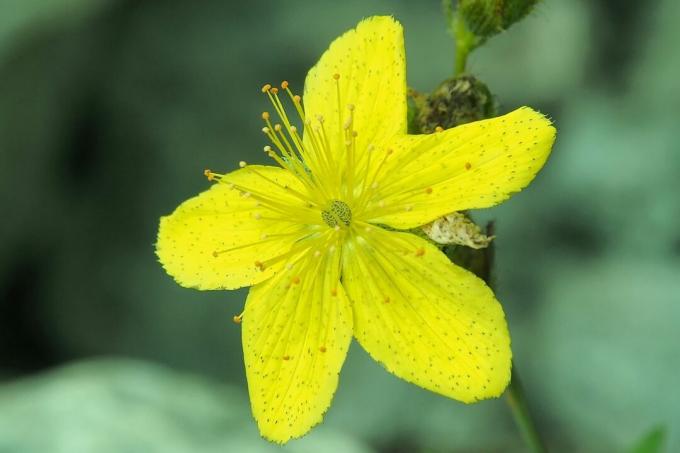
Winged St. John's Wort
The Winged St. John's Wort (Hypericum tetrapterum) is also colloquially referred to as winged St. John's wort or winged Hartheu. The water-loving perennial prefers a sunny to half-shady location on moist to boggy soil with an acidic to neutral pH. It can therefore also be planted well at the edge of the pond in the riparian zone. The reddish stem is winged on four sides, hence the name. St. John's wort grows to about 50 cm high and 40 cm wide and forms runners.
Large-flowered St. John's Wort
The large-flowered or large-flowered St. John's wort (Hypericum x patulum) is one of the highest species of St. John's wort. It reaches heights of growth of 100 to 120 cm and a width of up to 150 cm. The species originally comes from China and can withstand temperatures down to -15 °C. It grows overhanging and hemispherical. The 3 to 4 cm large, golden yellow flowers bloom between June and September. St. John's wort 'Hidcote' is a flowering variety that is a little sensitive to frost. It should therefore not be cut back in autumn so that neither water nor cold affect the plant. The part of the plant that has died above the ground is only cut back in the spring.

High St. John's Wort
High St. John's Wort (Hypericum moserianum) prefers fresh to moist garden soils in a sunny to partially shaded position. It reaches a height of 40 to 80 cm and flowers between June and October. The cup-shaped flowers hardly ever produce fruit. The high St. John's wort is usually evergreen and is therefore also an ornament in winter. The cultivar 'Tricolor' has attractive, conspicuously white and pink bordered leaves. It grows about 80 cm high and often just as wide.
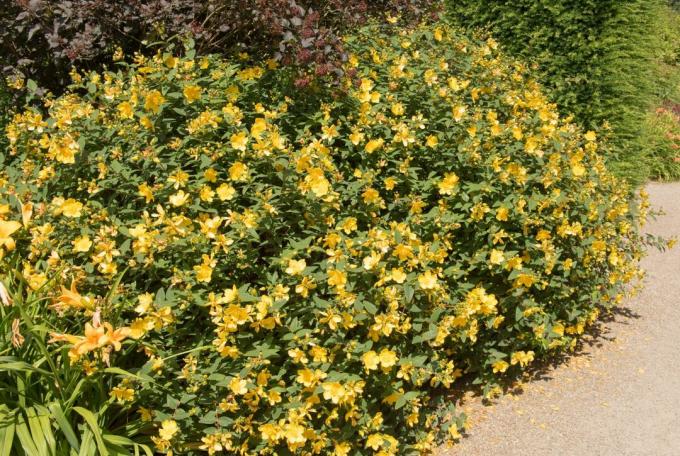
Canadian St. John's Wort
Canadian St. John's Wort (Hypericum kalmianum) is also known as dune St. John's wort. It is native to Canada and the northeastern United States as a wild plant. The almost evergreen shrub reaches heights of 60 to 100 cm and is often wider than it is tall. The quite small, cupped, light yellow flowers appear in abundance between July and September. The narrow, lanceolate to linear leaves and the ornamental fruit capsules from autumn are striking. The 'Gemo' variety initially grows stiffly upright, becoming broadly bushy when old. The undemanding small shrub thrives on all fresh to moist, well-drained, humus-rich soil with a slightly acidic to acidic pH value.
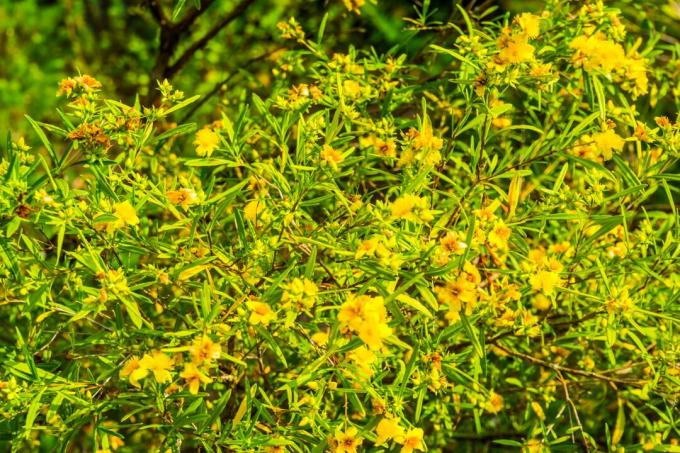
Chalice of St. John's Wort
The Calyx or Carpet St. John's Wort (Hypericum calycinum) originally comes from south-eastern Europe and occurs wild as far as Turkey. About 20 to 25 cm high, the subshrub that creeps through ground shoots forms oval-round, opposite and evergreen leaves. Planted in groups, this St. John's wort is suitable as ground cover. The approximately 7 cm large, golden-yellow flowers appear between July and September. The ideal location for this evergreen St. John's wort is semi-shady to sunny on dry to fresh, humus-rich soil under trees or at the edge of a forest.

Upholstery St. John's Wort
St. John's wort (Hypericum polyphyllum) spreads clump-like and cushion-like. It grows to a height of about 15 to 20 cm and has blue-green, tiny leaves. The terminal, cup-shaped, light yellow flowers appear between June and August. Several plants of this species can be planted together to cover the ground. The cushion St. John's wort prefers rather dry, well-drained and sunny locations. A particularly large-flowered selection is the St. John's wort variety 'Grandiflorum'.
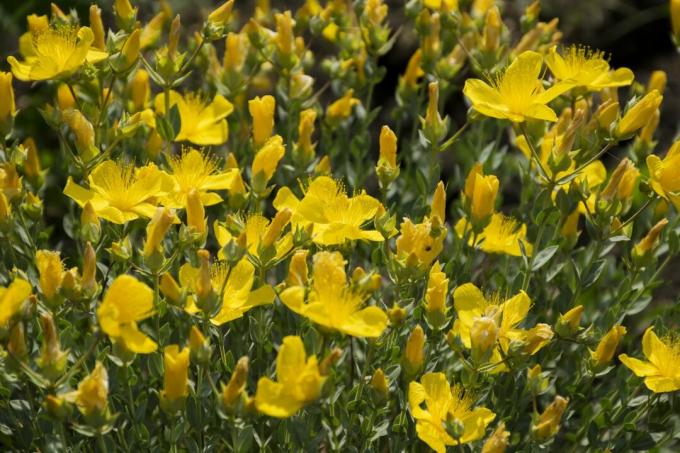
Beautiful St. John's Wort
The Beautiful St. John's Wort (Hypericum pulchrum) or heather St. John's wort is a native wild plant that is widespread in the mountains of Central Europe to southern Italy and can grow to a height of about 30 to 80 cm. It forms several stalks with encircling, almost triangular, coarse leaves, which are grey-green underneath. The small, golden yellow flowers appear between June and July. The beautiful St. John's wort avoids lime and therefore prefers acidic soils on heathland or at the edges of forests. It is completely hardy and occurs at altitudes of over 1000 meters.

Lemon St. John's Wort
The Lemon St. John's Wort (Hypericum hircinum) is suitable as a tea plant, because the young leaves and flowers have a pleasant scent of citrus fruits and camphor. Another name for Hypericum hircinum is wolf's wort. The species originally comes from the Mediterranean region, but is completely hardy to temperatures below -23 °C. The perennial with an average height of 50 to 80 cm and red stems grows in clumps and blooms light yellow between July and September. Conspicuous, spherical, reddish fruits form in autumn. The ideal location for the fragrant plant is on permeable, fresh to moist soil in a sunny to semi-shady location. The 'Loke' variety, which is up to 100 cm high, is particularly striking due to the reddish stems, buds and leaf colouration. In autumn, the striking reddish-brown fruits draw everyone's attention.

Dwarf St. John's Wort
The dwarf St. John's wort (Hypericum olympicum) is a rock garden dweller and thrives in dry, poor soil in full sun. The perennial has been around since the 18th century. Known for centuries and grows hemispherically and cushion-like. It reaches a height of 20 to 30 cm, has green, lanceolate small leaves and flowers between June and July. The small, golden-yellow flowers are arranged in umbels and form inconspicuous, capsule-like fruits after pollination. In winter, the perennial penetrates into the roots and sprout freshly in the following spring.
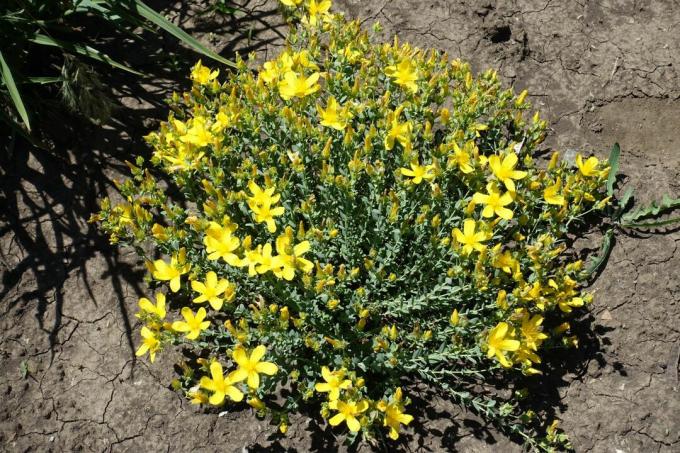
Many medicinal plants can also be planted and cultivated in our latitudes. We present you the 10 best Medicinal plants from your own garden and give tips on the effect and use.



